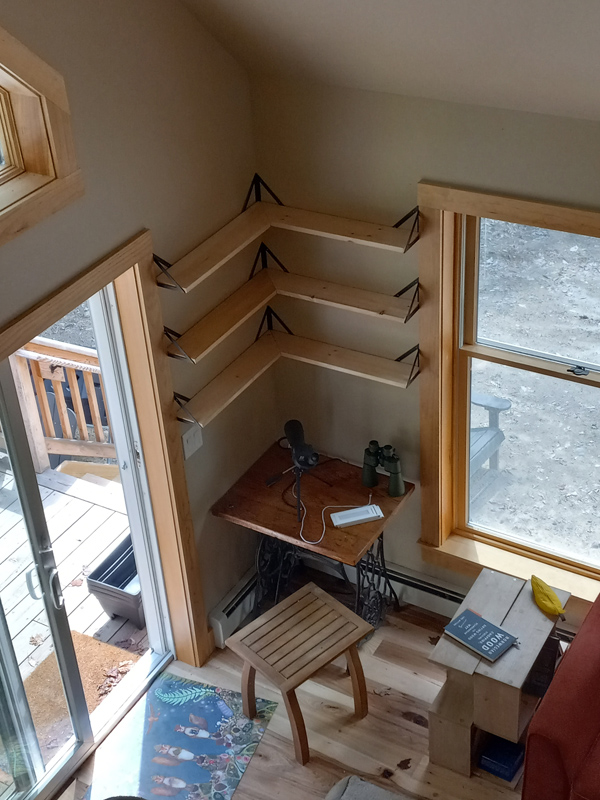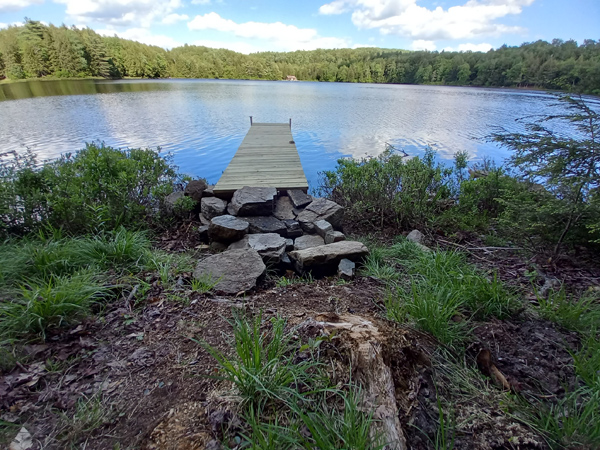|
|
|
custom bookshelf planking
Sunday, June 5 2022
location: 800 feet west of Woodworth Lake, Fulton County, NY
After the usual coffee and Spelling Bee Sunday morning cabin ritual, I began my work on a project near and dear to Gretchen: hanging some sort of shelves for books in the southeast corner of the cabin's great room (the only suitable space for such shelving). Gretchen had bought two Wallniture Minori kits of shelves that came with steel brackets, each of these having the shape of two triangles in two planes meeting in a line to form a prism. The planks to be supported by these prisms were sixteen inch planks made of what appeared to be real wood. Sixteen inches of plank suggested the prisms could be attached to studs (which, in our walls at least, are sixteen inches apart). But the holes in the prisms made this impossible for nearly all of the support screws, meaning that they are really intended to be hung on drywall anchors, and there are plenty such anchors supplied. But you know how I feel about drywall anchors, especially to support something as heavy as books. So I came up with an alternative plan. I would dispense with the supplied planks entirely and instead use the one by sixes used throughout the cabin as minimalist baseboard. These were a little narrower than the supplied planks, but they actually fit the prism brackets better than the supplied planks. Using custom planks, I could run from the edge of the window trim (which I could screw into from the side to get good load-bearing support) to the corner (where I could predictably find studs). And from there I could support a plank coming along the other wall, which would be running a similar distance from the trim around the sliding-glass doors to that same corner. If I mitred both planks, they could both be supported in the corner by a single prism. I ran a one-wall version of this idea by Gretchen and she gave me the thumbs-up. So I drilled new holes in all the brackets so they could be hung the way I wanted them, attached them to a corner stud and the sides of the trim pieces, and then fired up the generator so I could cut out the planks. Since the southeast corner measured about 91.5 degrees, I had to alter my usual 45 degree mitre cuts to get a satisfying fit. But once in place, the two planks of a shelf locked together so nicely that they didn't need any screws or other hardware to be secure.
Next I turned my attention to caulking the margins of the wall tile in the upstairs bathroom. Along with the overpriced grout, we'd bought surely-overpriced caulk in that same color that Gretchen decided she didn't like. Initially I thought it was latex caulk, but when I went to try and wash it off my hands, it didn't dissolve in water. It was, as it happened, 100% silicone. So I spent the next hour or so using multiple paper towels and lots of charcoal starter (it was easier to get into than paint thinner) to clean up all the messes, smears, and other minor caulking mishaps. And, as with the grout, there wasn't enough. I didn't even get around to caulking the most important seam: that between the tub and the floor. I'll probably use white caulk for that, since it will look better with the white tub and the light-colored floor grout.
Another issue that came up was when I tried to attach the tub spigot to the copper pipe I had sticking out of the wall. The spigot was designed to be easy to install, but then I couldn't get it flush against the wall, and when I tried to rotate it, the inner part with a set-screw disappeared from the little slot that had made it accessible, meaning there was no way I could remove the spigot and try something else, and yet the spigot was clearly too loose and far from the wall for this to be a final installation. As I cursed my fates and tried over and over to brute-force-rotate the spigot off the wall, I wondered how anyone could design such a piece of junk. Finally it did come off, and though it had somewhat mangled the copper pipe it had been attached to, I could still use it. Eventually I figured out how to get the spigot flush against the wall; hopefully the seal between the set-screw-mauled copper pipe and the spigot won't leak.
I needed a break from all the fumes and oily stuff on my skin, so I walked down to the lake with a beer, some Gorilla Glue, and the big chainsaw. Several trees had fallen across the lake trail over the winter, and I wanted to clear these out of the way. The first was easy, but the second was a large sugar maple about the same diameter as my saw's blade (19 inches). I had no way to pry it, so I was forced to cut it at spots where it was resting on the ground so as to avoid the kind of pinching that might've required me to abandon the saw. I was lucky and made two cuts about eight feet apart, and these were parallel enough that I could, with some effort, push the huge chunk of wood I'd just separated out of the way. With even more effort, I just barely (using my legs while seated firmly against the other part of the trunk) pushed it to a place where the trail was now once more open.
Down at the lake, I used the Gorilla Glue to repair a few little fuckups in yesterday's carpentry. (I didn't want board splits from failed screw attempts to mar the dock's appearance even slightly.) Then I used the chainsaw to cut a short piece of trunk that I notched at the top and then stuck beneath the dock about half way to prevent it from sproinging up and down as I walked on it. The dock has three two by eights as joists and should be pretty solid, but the sixteen foot span was a little too long. The support I installed today was intended as a temporary measure until I get more dock hardware and can install more permanent mid-span supports.
I took the kayak out and paddled to the south end of the lake to look at three other docks to get their measurements. The standard seems to be for 48 inch wide docks on two by six joists, all held up by anemic-looking 1.5 inch galvanized steel poles. The dock I'd just built is only 40 inches wide, which seems sufficient given that it will be a path to a wider floating dock. But it's otherwise much more substantial, with its deep joists, two-inch support poles, and massive stone abutment.
Before I left the lake, I looked out across its choppy surface and saw a single loon. I'd been hearing them off at Lake Edward, but hadn't heard any from Woodworth Lake and hadn't yet seen one this year.
Back at the cabin, I did some final straightening up and then loaded up the dogs and hit the road at around 5:30pm. I'd gotten as far as the four-way stop in Mecco when I realized I didn't have my fucking cellphone. I barely ever use it, but when I need it (usually for fucking Microsoft two-factor authentication) I really need it. So I drove all the way back to the cabin, finding my phone on the back of the big couch. When I hit the road a second time, it was nearly 6:00pm.
I started the drive with a road beer, and, as is customary when driving in either direction, cracked a beer open at the Catskill exit. Back at the house, I took a nice hot bath, ate some mac & cheese Powerful had made, and climbed into bed early. Gretchen had spent the day down in the City and wouldn't be back until around 11:00pm.

The new bookshelf with custom planks in the cabin. Click to enlarge.

The decked dock in daytime, seen with a wide-angle lens. Click to enlarge.

The bluegill sunfish that has been guarding a patch of lakefloor near the new dock. He or she is maybe six inches long, I think, though it's hard to say when seen in water.
For linking purposes this article's URL is:
http://asecular.com/blog.php?220605 feedback
previous | next |


